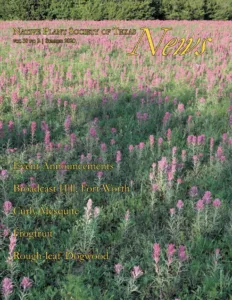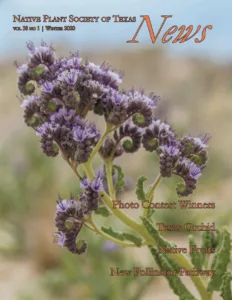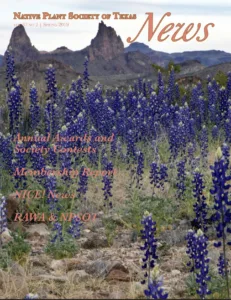Latest Issues

Fall 2025 Member Magazine
President’s Message | Executive Update | Celebrating Leadership | Curb Appeal with a Cause | Grant Recipients | Autumn’s Perfect Pairing | Native Plant Database | Sustainable Landscaping | Winterizing Tips

Summer 2025 Member Magazine
Executive Summary | Resilience in Bloom | Suburban Sanctuary | Texas-tough Summer Survivors | Where Salsa Meets Sage | A Rain Garden Grows | Member News | Smart Watering

Spring 2025 Member Magazine
Executive Summary | Blooming with Possibility | Wildflower Waltz | Native Grasses | Member News | Texas Wildflower Day
Distribution
- Texas Native Plants is published quarterly and the digital version is distributed free to all Society members in current standing.
- The digital version is also available in our library below.
- Print versions are mailed at no cost to Society members in current standing who select to receive a print copy when they join/renew.
- Libraries, educational institutions and other organizations may qualify to receive the publication for a $5 annual fee.
- Contact the membership coordinator.
- Many of our chapters publish their own newsletters and websites.
- These have their own deadlines and guidelines. See list of chapters.
History
Since its founding the Society has provided a news periodical to its members. there have been a variety of names and formats. The Texas Wildfower Newsletter edited by Carroll Abbott served as the first newsletter. He advocated the formation of the Native Plant Society of Texas in his quarterly publication Texas Wildflower Newsletter. After the Society was created in 1980, a free subscription to Abbott’s newsletter was provided as a benefit to all members. His declining health eventually prompted Abbott to request that the Society start its own newsletter. Lean more about the Carroll Abbott story.
Beginning in 1983 our own official publication has documented the evolution of the native plant movement and the Native Plant Society of Texas. The publication has had several slightly different names and formats over the years. By 2005 it had evolved into a full-color glossy magazine.
Editorial Submissions
The Native Plant Society of Texas encourages submission of articles, photos, pertinent news or other interesting information for publication.
- Submit articles or written items as email attachments.
- Send photos as email attachments in JPG, RAW or TIFF format.
- Larger file size and best quality are preferable.
- Contact the Editor for more information.
We reserve the right to edit all submissions for accuracy, relevance, length, grammar or for other reason. In matters of style our print publication generally follows the Chicago Manual of Style.
Unless prior arrangements with the editor are made, submissions may also appear on our website and linked on our social media pages. We do not accept outside advertising in any of our publications.
Publications Library
Click below to view issues by year/editor. Or visit our online archive.
2020 – Summer
- Broadcast Hill
- Curly Mesquite
- Frogfruit
- Roughleaf Dogwood
2020 – Spring
- Native Fruit
- Wild Bergamot
- Monarch Festival
2020 – Winter
- New Pollinator Pathway
- Photo Contest Winners
- Texas Orchid
2019 – Fall
- Hummingbirds
- Native Fruits
- Annual Symposium
2019 – Summer
- Contests for photos, videos and newsletters
- Willowleaf Sunflower
- Milkweed Moth
2019 – Spring
- Annual Awards & Contests
- Membership Report
- News About NICE
- RARA and NPSOT
2019 – Winter
- Flowering Plants of Trans-Pecos Texas and Adjacent Areas
- Muhlenberg and His Grasses
- The Restored River Basin
2018 – Fall
- Recreational Foraging
- Meet Neal Hinders
- Book Review: Native Host Plants for Texas Butterflies
2018 – Summer
- New Ventures – BBMT
- Summer Travel
2018 – Spring
- Your Remarkable Riparian
- Wimberley Valley Flood Recovery
- Blooms of Spring
2018 – Winter
- A Window into the Southern High Plains Native Flora
- Book Review: Common Rangeland Plants of West Central Texas
- Celebrating Winter Evergreens
2017 – Fall
- Botanizing in Texas, Part 2
- Book Review
2017 – Summer
- Botanizing in Texas, Part 1
- Enchanted Rock, A Natural and Human History
- Mexican Hat
- Remembering Shirley Lusk
2017 – Spring
- Bitterweed is boundless and beautiful
- The big four native perennial forbs of Texas
- Creating even a small habitat will attract birds
- This salvia is a true blue charmer
- Interstate 35 Monarch waystations moving along
2017 – Winter
- How to Work with a Grower
- Sowing Local in San Antonio
- Helping Our Ears Work Better
- 2016 Annual Awards
2016 – Fall
- Vote for Candidates for State Board and Fellow Award
- Fall Foliage in a Region Not Known For It
- Cibolo Nature Center and Acton Nature Center
- Youth Programs: Science Fairs and Photo Contests
2016 – Summer
- It’s Time for an Executive Director
- Invitation to Glen Rose
- Nature Boxes in Boerne
- 2016 Scholarship & Grant Recipients
2016 – Spring
- Texas Native Plant Art Exhibition
- Modern Tools for Field Identification
- A First-Timers Account at the Fall Symposium
- San Antonio River Authority and the NLCP
2016 – Winter
- Annual Awards
- Monarch Butterfly Rest Areas
- Encouraging Youth Programs
- Photo Contest Winners





















